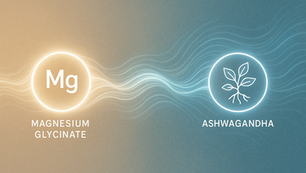top of page
Insights from Nature


Magnesium Glycinate and Vitamin B6: A Smart Pairing for Energy and Hormonal Balance?
Feeling fatigued, moody, or out of balance? You’re not alone. Stress, poor diet, & long workdays can deplete key nutrients that keep the nervous system steady & energy levels consistent. Two of the most important — & often overlooked — are magnesium & vitamin B6. Magnesium glycinate is a highly absorbable form that calms the body & supports hundreds of cellular functions. Vitamin B6 (pyridoxine) helps convert food into energy & regulates mood-related neurotransmitters. When t


Magnesium, Ashwagandha, and Turmeric: Can They Be Taken Together?
In the world of natural supplements, few combinations generate as much interest as magnesium, ashwagandha, and turmeric. Each offers unique benefits: magnesium supports calm and muscle recovery, ashwagandha helps the body adapt to stress, and turmeric reduces inflammation and supports joint health. But can you take all three together safely — and do they actually work better that way? Let’s explore what science and experience say about this powerful trio.


Magnesium Glycinate and Ashwagandha: Synergy for Stress Relief?
Chronic stress has become part of modern life — affecting sleep, mood, digestion, and even hormones. While medication and therapy remain vital tools, many people look to natural support to restore balance. Two of the most researched and effective natural ingredients are magnesium glycinate and ashwagandha. Magnesium helps calm the nervous system, while ashwagandha is an adaptogen that helps the body cope with stress. Taken together, they may offer deeper relaxation and resili


Mugwort vs Wormwood: Know the Difference, Use with Confidence
When the terms "mugwort" and "wormwood" come up, it is easy to get tangled in myths rooted in absinthe lore, medieval medicine, or just plain grocery store mix-ups. Both belong to the Artemisia family—but that shared heritage does not make them interchangeable. Knowing which herb fits which kitchen task or wellness approach can transform not just recipes, but well‑being routines too. This guide dives into the botanical truths, historical uses, and smart safety tips.


Magnesium Glycinate and L-Theanine: A Calming Combination?
Life today can feel overwhelming. Between stress, constant notifications, and busy schedules, many people are turning to natural ways to restore balance. Two of the most popular calming supplements are magnesium glycinate and L-theanine. Magnesium glycinate is well known for its ability to relax the nervous system and support deeper sleep. L-theanine, an amino acid found in green tea, promotes calm focus without sedation. Taken together, could they offer even greater benefits


Magnesium Glycinate and Vitamin D3: Do They Work Better Together?
Magnesium and vitamin D3 are two nutrients often discussed together, and for good reason. While vitamin D3 supports calcium absorption and bone strength, magnesium is essential for activating vitamin D in the body. Without magnesium, vitamin D may not work effectively. Magnesium glycinate, known for its high absorption and gentle effect on the stomach, is a popular choice for supplementation. But does combining magnesium glycinate with vitamin D3 really make a difference? Let


Magnesium Glycinate Combinations: How It Works with Vitamin D3, Vitamin B6, L-Theanine, Ashwagandha, and Turmeric
Magnesium glycinate has earned a reputation as one of the most effective and gentle forms of magnesium. Known for its calming effect, high absorption, and digestive comfort, it’s often chosen by people looking to improve sleep, ease stress, or reduce muscle tension. But what happens when you combine magnesium glycinate with other nutrients or herbs? Could pairing it with vitamin D3, vitamin B6, L-theanine, ashwagandha, or turmeric enhance its benefits?


Dandelion and Holy Basil: Adaptogen and Detox Synergy
Some herbal pairings are designed to cleanse the body, while others focus on balance and resilience. The combination of dandelion and holy basil does both. Dandelion root offers gentle detox and liver support, while holy basil—also known as tulsi—is an adaptogen that helps the body manage stress. Together, they create a blend that supports immunity, detox, and stress balance.


Dandelion and Lemon Balm: Stress Relief and Digestive Comfort
When looking for herbal blends that soothe both the body and mind, few combinations are as calming as dandelion and lemon balm. Dandelion root is known for its role in gentle detox and digestive support, while lemon balm has been valued for centuries as a calming herb for stress and restlessness. Together, they form a balanced blend that promotes stress relief and digestive comfort. This article explores how these two herbs complement each other, the forms in which they are c


Dandelion and Ceylon Cinnamon: Blood Sugar Support Naturally
Herbal pairings are often designed to complement each other’s strengths. One such combination gaining attention is dandelion and Ceylon cinnamon. Dandelion root offers detox and liver support, while Ceylon cinnamon is prized for its antioxidant properties and role in blood sugar balance. Together, they create a natural blend for metabolic wellness.
This article explores the science behind the pairing, how each herb works, and safe ways to use them in daily routines.


Dandelion and Ginger: Digestion and Circulation Support
Among herbal pairings, few are as complementary as dandelion and ginger. Dandelion root is valued for gentle detox and liver support, while ginger is known worldwide for its digestive and circulatory benefits. Together, they form a blend that supports gut health, relieves bloating, and improves overall vitality. This article explores how the two herbs work individually, why combining them makes sense, and the best ways to use them for everyday wellness.


Dandelion and Turmeric: Detox and Anti-Inflammatory Duo
Two herbs often mentioned together for wellness are dandelion and turmeric. Each has a long history of traditional use and increasing scientific attention. When combined, they create a unique pairing that may support detoxification, reduce inflammation, and promote overall joint and liver health.
This article explores why dandelion turmeric detox blends are gaining interest, how the two herbs complement each other, and the safest ways to use them.


How Dandelion, Turmeric, Ginger, Ceylon Cinnamon, Lemon Balm, and Holy Basil Work Together for Wellness
IntroductionHerbs have long been used not just individually but also in blends, where one plant’s benefits complement another’s. Among these, dandelion root stands out as a versatile detoxifying herb. Traditionally valued for its support of the liver, kidneys, and digestion, dandelion root today is often combined with other botanicals to create well-rounded blends that target multiple aspects of wellness.This article explores the science behind dandelion root blends, focusing


What Not to Mix with Dandelion Root (Safety Guide)
Introduction Dandelion root ( Taraxacum officinale ) is widely consumed as tea, tincture, or dandelion capsules . It supports digestion, liver health, and detox. But like all herbs, it may not be safe to combine with everything. So, what not to mix with dandelion root? This guide reviews medications, supplements, and herbs that may cause interactions, and offers tips to keep your dandelion root supplement safe. Why Mixing Matters Dandelion root has natural diuretic , antioxid


Best Time to Drink Dandelion Root Tea: Morning or Night?
Dandelion root tea has become a favorite herbal drink for digestion, detox, and overall wellness. But many people still ask: when to take dandelion root tea? The answer depends on your health goals. Some benefits are stronger in the morning, while others make sense in the evening. And for those who prefer convenience, dandelion capsules and other dandelion supplements can provide similar support without brewing.


Dandelion Root in Spanish: What It’s Called and How It’s Used
When researching herbs online, you may notice that people sometimes search for “dandelion root in Spanish.” This not only helps bilingual readers but also improves clarity when buying teas, tinctures, or dandelion supplements in Spanish-speaking regions. So, what is dandelion root called in Spanish, and how has it traditionally been used? Let’s explore.


Dandelion Root and Burdock Root: Detox and Skin Health Benefits
Introduction Herbal traditions often pair plants with complementary benefits. One powerful duo is dandelion root ( Taraxacum officinale ) and burdock root ( Arctium lappa ). Both have long been valued for their roles in detox, digestion, and skin health. Today, these herbs appear together in teas , powders , and dandelion supplements designed for cleansing and wellness. This article explores their similarities, differences, and safe use. Dandelion Root Benefits Digestive Sup


Dandelion Root vs Dandelion Leaf Tea: Different Benefits Explained
The dandelion plant (Taraxacum officinale) has been used in herbal traditions for centuries. But when it comes to teas and supplements, there’s often confusion about dandelion root vs leaf. Both parts of the plant offer unique health benefits. Understanding their differences can help you choose between root-based teas, leaf teas, or a blend. This article compares dandelion root vs dandelion leaves, explains the benefits of dandelion root and leaf tea, and shares practical tip


The Ultimate Guide to No-Carve Pumpkin Decorations for Halloween
Every October in the United States, pumpkins become the stars of front porches, living rooms & Halloween parties. While carving jack-o’-lanterns is a tradition, not everyone wants to deal with the mess (or the knives). Enter: no-carve pumpkin decorations. These creative, safe, & eco-friendly alternatives let you celebrate the spooky season without cutting into your pumpkin. Whether you’re decorating with kids, looking for mess-free DIY, or simply want pumpkins that last longe


Dandelion Root and Milk Thistle: A Powerful Liver Support Duo?
For centuries, herbal medicine has relied on plants to support liver function. Among the most researched are dandelion root (Taraxacum officinale) and milk thistle (Silybum marianum). Both are popular in modern wellness, often found in teas, extracts, or dandelion supplements. But how do they compare, and can they be used together for liver support? This article reviews their unique benefits, differences, and safe usage.


Who Should Avoid Dandelion Root? (Pregnancy, Gallstones, Allergies)
Dandelion root (Taraxacum officinale) is a popular herbal remedy used in teas, tinctures, and dandelion supplements like capsules. While generally safe for healthy adults, not everyone should use it. So, who should not take dandelion root? This article reviews situations where caution—or complete avoidance—is necessary, with a focus on pregnancy, gallstones, and allergies.


Dandelion Root Dosage: How Much Is Safe Per Day?
Introduction With growing interest in herbal wellness, many people turn to dandelion root for liver support , digestion, and gentle detox . But like any supplement, it’s important to ask: How much is safe to take each day? The answer depends on the form— tea , tincture , powder , or dandelion capsules —and individual health factors. This guide reviews recommended daily dosage, safety tips, and practical advice. General Safety Considerations Dandelion root is considered safe f


Dandelion Root Side Effects and Interactions: What to Know Before Taking Supplements
Introduction While dandelion root has a long history of safe use in traditional medicine, no herb is completely free of risks. With its growing popularity in teas , e xtracts , and dandelion supplements , it’s important to understand possible side effects, drug interactions, and safe dosage guidelines. This article reviews what research and clinical sources say about dandelion root safety so readers can make informed choices. Common Side Effects Digestive Upset Some people m


Dandelion Root Powder: How People Use It in Smoothies and Recipes
Introduction Among the many ways to enjoy dandelion root ( Taraxacum officinale ), powder form is one of the most versatile. Unlike tea or tinctures , dandelion root powder can be blended into smoothies, recipes, and daily foods, making it a popular choice for wellness enthusiasts. But what benefits does powdered root provide, how does it compare to other dandelion supplements , and what are the best ways to use it? Let’s explore. What Is Dandelion Root Powder? Made by dryin
bottom of page